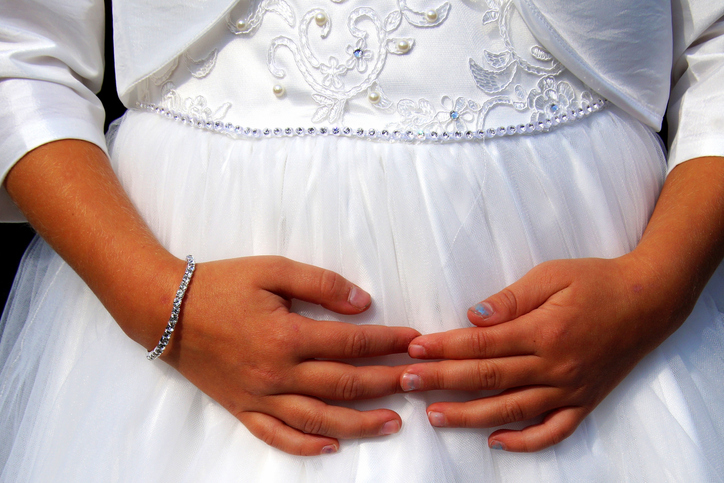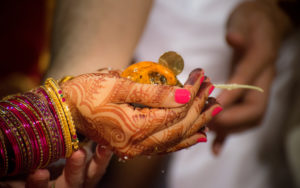
When looking at institutional sex abuse, there is one frequently overlooked institution — the institution of marriage. There are many states that allow children, those under 18, to enter into the legal contract of marriage. Sometimes, parental consent is required to allow those under 18 to marry. Other times it is not. What is less known about child marriage is that many times it is forced upon the child by adults for various reasons: an unplanned pregnancy, obtainment of immigration status for a family member, cultural, religious, or financial reasons, and in some cases, to cover up sexual abuse.
A lesser known fact is that most children who marry in the US are minor girls married to adult men. Often, the marriage certificate is the only thing preventing the adult man from being charged with statutory rape. Research has consistently demonstrated that when young girls are forced to marry, they are more likely to be victims of domestic violence, lost educational and economic opportunities, and suffer long-term negative health consequences.
There is a growing movement to set the minimum age for marriage across all states to 18 with no parental consent exception.
This law would do away with the marital exemption for statutory rape. By following the lead of NJ and Delaware’s decision to set the minimal age at 18 without exceptions, states can curb the inadvertent sanctioning of child sexual abuse through marriage.
Child Marriage vs. Forced Marriage
 Child Marriage is defined as a marriage of a girl or boy before the age of 18 and refers to both formal marriages and informal unions. Religious organizations such as the Mormons will perform “sealing” ceremonies that do not require parental consent as they are not legally recognized, but they can allow for an adult to have sexual access to a minor. As recently as 2010, the Tennessee courts allowed three 10-year-old girls to marry.
Child Marriage is defined as a marriage of a girl or boy before the age of 18 and refers to both formal marriages and informal unions. Religious organizations such as the Mormons will perform “sealing” ceremonies that do not require parental consent as they are not legally recognized, but they can allow for an adult to have sexual access to a minor. As recently as 2010, the Tennessee courts allowed three 10-year-old girls to marry.
Research indicates that 77% of the children wed in the US were minor girls married to adult men, often with significant age differences. Many of these children were wed at an age, or with a spousal age difference, that constitutes statutory rape under their state’s laws. The assumption behind the statutory rape law is that the person, by virtue of their age, power inequality, and vulnerability, is not able to consent to sexual activity. Regardless of the person’s “willingness” to participate in a marriage as a minor, they are not capable of fully providing consent.
Oddly, minors have legal limitations when it comes to accessing services or signing legal documents. Though these children can be married, they can’t initiate divorce legally, nor can they register themselves for services that would help them extricate themselves from an abusive marriage (some welfare benefits and domestic abuse shelters).
Forced marriage is when one or both parties enters without full, free, informed consent. Further, even if both parties enter a marriage with full, free, informed consent, the union can later become a forced marriage if one or both parties is forced to stay in it because of the economic limitation or social isolation that is often inherent in these arrangements.
 Many cultures participate in the tradition of arranged marriages, but often, the woman is not able to object to these unions due to strong family or community pressure, and the economic realities of their options. Numerous communities in the US that are known to practice arranged/forced marriage: Orthodox Jewish, Muslim, Mormon, Sikh, Asian, African, and Hmong. Forced marriage is also quite common among immigrant communities in the United States. Women as young as 13 years old are often forced to marry older men from their home country, so they can apply for Visas.
Many cultures participate in the tradition of arranged marriages, but often, the woman is not able to object to these unions due to strong family or community pressure, and the economic realities of their options. Numerous communities in the US that are known to practice arranged/forced marriage: Orthodox Jewish, Muslim, Mormon, Sikh, Asian, African, and Hmong. Forced marriage is also quite common among immigrant communities in the United States. Women as young as 13 years old are often forced to marry older men from their home country, so they can apply for Visas.
Additionally, there are parents who pressure and coerce marriage on their children in reaction to unplanned pregnancies. As a result, there are many children in the US who are forced into marriage. More than 200,000 minors were married in the U.S. between 2000 and 2015. Despite the various reasons for these child marriages, the outcome for most people is the same; poor health outcomes, reproductive health compromises, and limited economic and educational opportunities.
Lack of Education Leads to Poverty
 Child marriage often prevents women from continuing their education. Women who marry before the age of 19 are 50% more likely to drop out of high school and four times less likely to finish college. Because of a lack of education, women who marry early earn lower wages and are significantly more likely to live in poverty. This also can increase the dependence on their husbands, reinforcing the fact that child brides are often trapped in their marriages even into adulthood.
Child marriage often prevents women from continuing their education. Women who marry before the age of 19 are 50% more likely to drop out of high school and four times less likely to finish college. Because of a lack of education, women who marry early earn lower wages and are significantly more likely to live in poverty. This also can increase the dependence on their husbands, reinforcing the fact that child brides are often trapped in their marriages even into adulthood.
Child brides can find them in relationships where they have limited power or autonomy, making them vulnerable to domestic violence, emotional or physical abuse, and abandonment. Numerous studies have found child brides to have higher incidents of violence, both domestically and internationally, than their older, married counterparts.
Long Term Health Consequences
 Many studies have been conducted on the long-term health consequences that often result from child marriages. Child marriage is one of the key determinants of early pregnancies. Girls between the ages of 15 and 19 are twice as likely to die in childbirth as women in their 20’s. Women who married at 18 or younger have a 23% greater risk of disease onset, including heart attack, diabetes, cancer and stroke. Child marriage is also associated with higher rates of sexually transmitted infections (including HIV). This is partly because brides may not know enough or feel confident enough to negotiate safe sexual behaviors and access to medical care with their adult counterparts.
Many studies have been conducted on the long-term health consequences that often result from child marriages. Child marriage is one of the key determinants of early pregnancies. Girls between the ages of 15 and 19 are twice as likely to die in childbirth as women in their 20’s. Women who married at 18 or younger have a 23% greater risk of disease onset, including heart attack, diabetes, cancer and stroke. Child marriage is also associated with higher rates of sexually transmitted infections (including HIV). This is partly because brides may not know enough or feel confident enough to negotiate safe sexual behaviors and access to medical care with their adult counterparts.
Child marriage can also have devastating psychological impacts. A study published in 2011 determined that child marriage in the US was significantly associated with almost all mental disorders. Girls under 18 who get married are more likely to experience depression, anxiety, bipolar disorders, and addiction issues. A study published in Science Daily claims that child marriage should be considered a “public health issue”. Why does the United States government have many initiatives to address the health problems listed above, yet continues to allow child marriage to contribute to these health issues?
Developmental Risk to Babies of Teen Moms
 On top of the health consequences that child brides face themselves, the newborn children of younger mothers have greater risks of infant mortality than mothers who have children in their 20’s. If a mother is younger than 18, an infant has a 60% greater likelihood of dying during the first year of childbirth. Newborns born to adolescent mothers also are more likely to have a low birth weight. In addition, a developing child growing up in a household with a higher likelihood of domestic violence and poverty will likely face a myriad of physical and psychological consequences in adolescence and adulthood.
On top of the health consequences that child brides face themselves, the newborn children of younger mothers have greater risks of infant mortality than mothers who have children in their 20’s. If a mother is younger than 18, an infant has a 60% greater likelihood of dying during the first year of childbirth. Newborns born to adolescent mothers also are more likely to have a low birth weight. In addition, a developing child growing up in a household with a higher likelihood of domestic violence and poverty will likely face a myriad of physical and psychological consequences in adolescence and adulthood.
The Teenage Brain and Development
 The human brain does not fully develop until an individual is approximately 25 years old. Specifically, the frontal lobe, responsible for many aspects of decision making, is one of the last parts of the brain to develop. As a result, many of the age requirements for activities with long-term consequences are being raised. For example, people can not buy alcohol, get an airplane license, or adopt a child until the age of 21. How is a 14-year-old child supposed to make an informed decision about marriage?
The human brain does not fully develop until an individual is approximately 25 years old. Specifically, the frontal lobe, responsible for many aspects of decision making, is one of the last parts of the brain to develop. As a result, many of the age requirements for activities with long-term consequences are being raised. For example, people can not buy alcohol, get an airplane license, or adopt a child until the age of 21. How is a 14-year-old child supposed to make an informed decision about marriage?
Marriage still implies the assumption of the union lasting forever, but research shows that children aren’t typically emotionally or intellectually developed enough to make decisions with that type of permanent implication. Compared to a national divorce rate of about 50 percent, between 70 and 80 percent of child marriages end in divorce.
In March of 2016 the US Department of State declared that child marriage is a “human rights abuse that produces devastating repercussions for a girl’s life, effectively ending her childhood.” We think of child marriage as a human rights violation when it happens elsewhere, but here in our own country, these problems are present. It is hard to believe that in America, we have so many young girls forced into marriage as children. The consequences to these girls last long into adulthood and effectively limit their opportunities to thrive, grow, and live up to their potential.



Join the Conversation